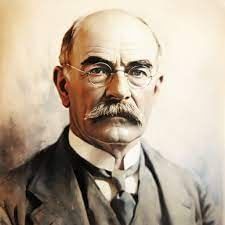Summary: The Way Through the Woods | English Class 6 ICSE PDF Download
| Table of contents |

|
| Introduction |

|
| Key Points of the Poem |

|
| Summary |

|
| Message |

|
Introduction
"The Way Through the Woods" is a beautiful poem written by Rudyard Kipling, a famous English poet and storyteller. Kipling is best known for his works like "The Jungle Book" and "If—." In this poem, he describes an old road in the woods that has disappeared over time. The poem creates a sense of mystery and wonder, making us think about nature, the past, and how time changes things. It uses simple yet vivid language to paint a picture of the woods and the memories they hold.
 Rudyard Kipling
Rudyard Kipling
Key Points of the Poem
- The poem explores the story of an old road that was closed seventy years ago and is now hidden by nature.
- It explains how weather and rain have destroyed the road, making it disappear under trees, plants, and wild growth.
- It highlights the role of nature, with trees and plants like coppice, heath, and anemones covering the lost path.
- It mentions the keeper as the only one who remembers the road’s existence where animals like ring doves and badgers now live.
- It describes a mysterious experience in the woods during a summer evening, where sounds of a horse and a skirt are heard despite the road being gone.
- It raises questions about whether these sounds come from ghosts or are just memories of people and events from the past.
- It emphasizes the wild freedom of nature and how animals in the woods are not afraid of humans because they rarely see them.
- It creates a sense of mystery and imagination about the past life along the old road.

Summary
Stanza 1
They shut the road through the woods
Seventy years ago.
Weather and rain have undone it again,
And now you would never know
There was once a road through the woods
Before they planted the trees.
It is underneath the coppice and heath,
And the thin anemones.
Only the keeper sees
That, where the ring dove broods,
And the badgers roll at ease,
There was once a road through the woods.
This stanza tells us that a road through the woods was closed seventy years ago. Over time, rain and weather have worn it away completely, so now it is impossible to tell that a road ever existed. The area where the road once was is now covered with trees and plants, including coppice, heath, and thin anemones. Only the keeper, who looks after the woods, can still recognize that this place was once a road. He sees that where birds like the ring dove sit on their eggs and badgers roll around comfortably, there used to be a path for people to walk on.
Stanza 2
Yet, if you enter the woods
Of a summer evening late,
When the night-air cools on the
trout-ringed pools
Where the otter whistles his mate,
(They fear not men in the woods,
Because they see so few.)
You will hear the beat of a horse's feet,
And the swish of a skirt in the dew,
Steadily cantering through
The misty solitudes,
As though they perfectly knew
The old lost road through the woods...
But there is no road through the woods.
This stanza invites us to visit the woods late on a summer evening. As the night air becomes cool, you can see pools of water with trout and hear otters calling to their mates. The animals in the woods are not scared of people because humans rarely visit. If you listen carefully, you might hear the steady sound of a horse’s feet and the soft rustle of a skirt moving through the wet grass. These sounds seem to follow an old path, even though the road no longer exists. The poem suggests that these noises come from someone who knows the lost road well, creating a feeling of mystery as there is no real road left.
Message
The poem teaches us about the power of nature to hide the past and how old memories can linger in our minds. It encourages us to imagine the lives of people who once used the road and to feel the mystery of the woods. It also shows how nature takes over when humans are no longer around, making us think about the connection between the past and the present.
New Words with Meanings
- Coppice: A woodland where trees are cut down to stumps to help them grow back.
- Heath: A wild, open area covered with small bushes and shrubs.
- Anemones: Beautiful wild flowers with bright colors.
- Broods: When a bird sits on its eggs to keep them warm and help them hatch.
- Beat: A regular, rhythmic sound, like the steps of a horse.
- Solitudes: Quiet and lonely places where few people go.
- Cantering: Moving at a steady, gentle speed, often used to describe a horse’s gait.
- Trout-ringed pools: Ponds or small lakes where trout fish swim and create rings on the water’s surface.
|
38 docs|19 tests
|
FAQs on Summary: The Way Through the Woods - English Class 6 ICSE
| 1. What are the main themes explored in "The Way Through the Woods"? |  |
| 2. How does the imagery in "The Way Through the Woods" contribute to its overall message? |  |
| 3. What literary devices are used in "The Way Through the Woods"? |  |
| 4. What is the significance of the title "The Way Through the Woods"? |  |
| 5. How does the poem reflect the poet's view of nature? |  |














